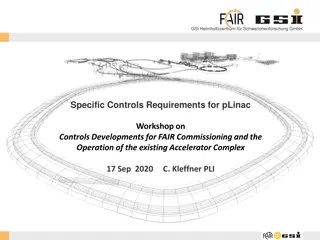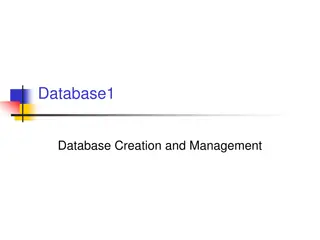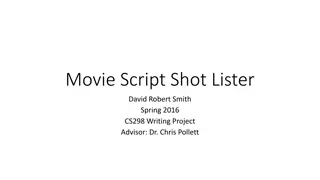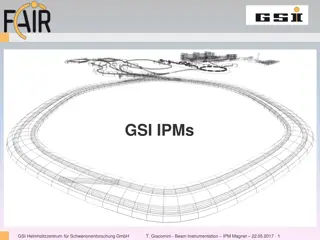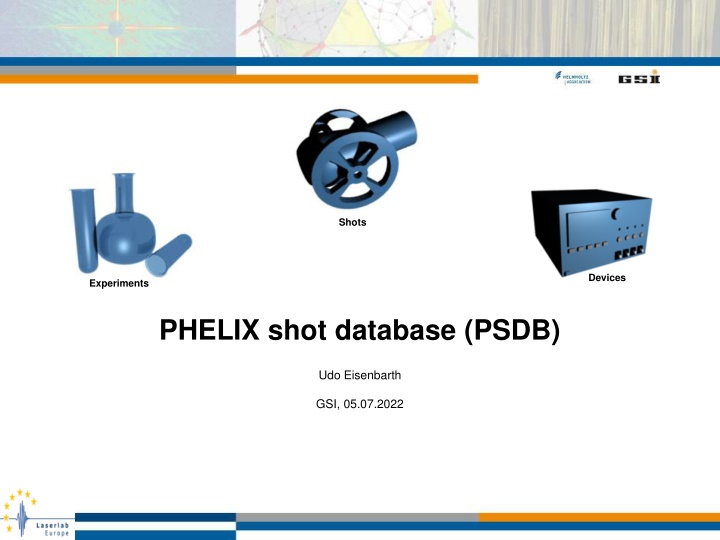
Improved Data Management System for PHELIX Laser Experiments
Enhance efficiency with a new shot database system for PHELIX laser experiments, ensuring reliable data storage, easy access, and comprehensive shot analysis capabilities.
Download Presentation

Please find below an Image/Link to download the presentation.
The content on the website is provided AS IS for your information and personal use only. It may not be sold, licensed, or shared on other websites without obtaining consent from the author. If you encounter any issues during the download, it is possible that the publisher has removed the file from their server.
You are allowed to download the files provided on this website for personal or commercial use, subject to the condition that they are used lawfully. All files are the property of their respective owners.
The content on the website is provided AS IS for your information and personal use only. It may not be sold, licensed, or shared on other websites without obtaining consent from the author.
E N D
Presentation Transcript
Shots Devices Experiments PHELIX shot database (PSDB) Udo Eisenbarth GSI, 05.07.2022 laserlabLOGO
PHELIX in a nutshell Petawatt High Energy Laser for heavy Ion eXperiments Single laser shots pulse energy: 250 J 0.5 PW pulse duration: 500 fs 2 * 1021W/cm focal spot size: 10 m in operation since 2010 > 22,000 shots delivered > 120 experiments served full system shot every 90 minutes laserlabLOGO
PHELIX control sytem > 10,000 process variables based on LabVIEW > 25 PCs > 350 devices (>25 cameras, >50 stepper motors, oscilloscope, spectrometers, .) laserlabLOGO
The situation during the early days of PHELIX Documenting PHELIX operation is far away from being optimal: Manual shot documentation (Excel table) error prone Non-standard measurement data stored in single files ( somewhere ) No search for certain shot data Difficult to compare shots / shot series Accessible from only one computer laserlabLOGO
Requirements for the shot database Technical Reliable data storage Storage of arbitrary data types (numeric, strings, images, spectra, ) Flexible enough to handle changes of the laser setup Possibility to add user data (as attachments) Possibility to extend (e.g. bug reporting) Shot analysis: Search and compare shots Generation of shot statistics Group shots by experiment Group shots by shot type (test shot, experiment shot) Handling As little maintenance effort as possible Easy access from everywhere Access policy laserlabLOGO
Design considerations 1: Workflow Create experiment entry via web interface (once at beginning of beamtime) Shot Procedure Select experiment (can be set to a default) Select shot type (test shot, experiment shot) Press shot button (Optional) Add /modify comment to shot via web interface (no further data needed) (Optional) Attach additional data files to shot via web interface laserlabLOGO
Design considerations 2 Shot-based data: Camera 1 Image: Exposure Time: 20 s Shot Camera 2 Id (Shot Number) Image: Timestamp Exposure Time: 15 s Comment Powermeter 5 Experiment Energy: 123 J Shot type Shutter 4 Position: open No continuous data recorded (so far): permanent measurements (e.g. vacuum) laserlabLOGO
Database <-> Web comunication PHELIX Control system (PCS) Database Postgres@GSI Webserver https://psdb.gsi.de accessible worldwide, full user roles / privileges management Web browser API Access View & Export data to file https://psdb.de?device=PA_Camera&shot=123 Interface libraries available for LabVIEW, MatLab, Python laserlabLOGO
PSDB statistics Total number of shots: 18759 Number of experiment shots: 8408 Average #shots / experiment: 69 14 subsystems 48 class types 350 instantiated objects stored measurement values: > 28.1 million total database size: 130 GB (13 GB / year) laserlabLOGO
Shortcommings, issues, challenges shot-based data only (no time-based measurements) very little metadata so far (facility documented in internal wiki) scalability? (higher shot rates ) no experiment data: highly volatile setups (changing every few weeks) experimentalist s responsibility file attachments possible laserlabLOGO
High-Intensity Laser-Plasma Metadata format Variety of laser systems, experimental setups and detectors No experiments are identical No existing metadata standard Difficult to compare experiments Proposal of HZDR, HI-Jena and GSI for HMC: Developing a metadata standard for the high-intensity laser-plasma community: Helmholtz Laser-Plasma Metadata Initiative (HELPMI) Metadata compliant extension for laser data to PSDB Availability and usability of laser data for external users Thank you for your attention laserlabLOGO

